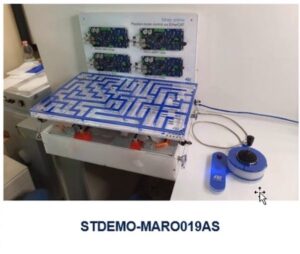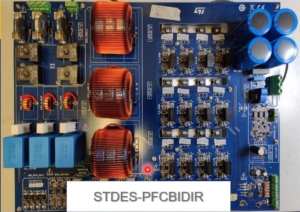On December 2nd, 2020, ST will hold its Industrial Summit 2020 in Shenzhen, China. We will offer more than 50 technical presentations, showcase more than 100 demos, and have experts available to answer questions or offer suggestions. To make it meaningful to all attendees, the Industrial Summit 2020 will revolve around three primary avenues: motor control, power and energy, as well as automation. However, instead of merely laying out its portfolio, ST wanted to shine a light on trends that are shaping innovations. Hence, the conference will be an opportunity to witness the latest push toward greater precision, efficiency, and communication.
Industrial Summit 2020: Motor Control, Toward Greater Precision
Fixing Vibration and Noise Issues with a New Evaluation Board
 ST will show a new evaluation board, from our competence center, capable of finding the rotor’s angle. Developers will appreciate its open firmware (X-CUBE-MCSDK) since it gives them the ability to reuse our source code into their application. Moreover, the whole solution rests on an STSPIN32F0601, which includes a low-power STM32F031 microcontroller for greater energy and cost-efficiency. Additionally, the inverter stage uses a trench gate field stop IGBT similar to the STGD5H60DF. As a result, designers can look at our implementation and see how to lower switching losses. Hence, the custom board is more than a simple development tool but an object lesson for engineers looking to build quieter and more reliable products.
ST will show a new evaluation board, from our competence center, capable of finding the rotor’s angle. Developers will appreciate its open firmware (X-CUBE-MCSDK) since it gives them the ability to reuse our source code into their application. Moreover, the whole solution rests on an STSPIN32F0601, which includes a low-power STM32F031 microcontroller for greater energy and cost-efficiency. Additionally, the inverter stage uses a trench gate field stop IGBT similar to the STGD5H60DF. As a result, designers can look at our implementation and see how to lower switching losses. Hence, the custom board is more than a simple development tool but an object lesson for engineers looking to build quieter and more reliable products.
Solving Cost Challenges With Multi-Axial Position Control
 ST teams will also demonstrate how engineers can obtain greater accuracy with a real-life interactive maze. A labyrinth will sit on a reasonably large tabletop (60 cm x 35 cm 47 cm or 24 in x 14 in x 19 in), and our engineers will then place a motor at each corner to tilt the surface. Users will have the opportunity to control the motors, move the table, and guide a ball through the maze. Each of the four motors is controlled by a PCB that includes an STDRIVE601 gate driver, an STH270N8F7 power MOSFET, and an STM32F767ZI microcontroller, thus showcasing a complete design with a relatively low bill of material. The commercial version of that board, which we will call STEVAL-ETH001V1, will have an STDRIVE101 instead of the STDRIVE601.
ST teams will also demonstrate how engineers can obtain greater accuracy with a real-life interactive maze. A labyrinth will sit on a reasonably large tabletop (60 cm x 35 cm 47 cm or 24 in x 14 in x 19 in), and our engineers will then place a motor at each corner to tilt the surface. Users will have the opportunity to control the motors, move the table, and guide a ball through the maze. Each of the four motors is controlled by a PCB that includes an STDRIVE601 gate driver, an STH270N8F7 power MOSFET, and an STM32F767ZI microcontroller, thus showcasing a complete design with a relatively low bill of material. The commercial version of that board, which we will call STEVAL-ETH001V1, will have an STDRIVE101 instead of the STDRIVE601.
Users control the system through a joystick that integrates inertial sensors. The joystick can send data wirelessly to an X-NUCLEO-IDB05A Bluetooth shield or on a wired connection to a Hilscher network controller. Put simply, the stick sends its position to a control board, which will compute the position for each motor thanks to an inverse kinematic algorithm. The data is then sent from the board to the motors through EtherCAT Real Time link. This demo thus solves the issue of interconnections between motors and shows how a team could use real-time communication to apply position control in a factory automation setting.
Industrial Summit 2020: Power and Energy, Toward Greater Efficiency
Resolving Car Charger Problems with Silicon Carbide
 The Industrial Summit 2020 will be an exciting venue to highlight a new challenge that plagues the EV market. As electric cars become more popular and mainstream, consumers want faster charging. Manufacturers can help with intuitive mobile applications, better fuel gauges, and rapid charging. Unfortunately, engineers are hitting a new limit when it comes to the size of public and private charging stations. Indeed, cities don’t want massive structures that won’t fit in crowded centers. Similarly, citizens hope their charger takes as little space in their garage as possible. Hence, the problem comes from the fact that users want more power while also demanding a smaller form factor.
The Industrial Summit 2020 will be an exciting venue to highlight a new challenge that plagues the EV market. As electric cars become more popular and mainstream, consumers want faster charging. Manufacturers can help with intuitive mobile applications, better fuel gauges, and rapid charging. Unfortunately, engineers are hitting a new limit when it comes to the size of public and private charging stations. Indeed, cities don’t want massive structures that won’t fit in crowded centers. Similarly, citizens hope their charger takes as little space in their garage as possible. Hence, the problem comes from the fact that users want more power while also demanding a smaller form factor.
One way to solve this dilemma is with the STDES-PFCBIDIR, a three-phase bidirectional converter for electric vehicles. Thanks to its SCTW35N65G2V Silicon Carbide MOSFET, it enables the creation of significantly more efficient converters. The device is also present on the STDES-VINNARECT board, which was the subject of a recent webinar. Thanks to its wide bandgap, the SiC MOSFET has a higher switching frequency that vastly increases efficiency in high voltage applications. As a result, engineers can develop smaller chargers while offering more power. The STDES-PFCBIDIR also uses an STM32G474 because, among other things, its high-resolution timer means engineers can more easily drive SiC MOSFETs and use smaller passive components, thus lowering the bill of materials.
Overhauling Smartphone Chargers With Gallium Nitride
Consumer electronics is facing a similar problem with the advent of USB power delivery. New smartphones and tablets all support fast charging technologies that demand more power. Unfortunately, the chargers compatible with these new specifications remain big and expensive, which explains why manufacturers often don’t include them in the box. Users have to purchase a higher power charger separately, which already led some consumers to decry this practice. Hence, mobile device makers are looking for more efficient fast chargers, but silicon technology limitations hamper their efforts.
ST will have a reference design for a 65 W charger at the Industrial Summit 2020 that solves this challenge. Thanks to the presence of our MasterGaN1 device, our demo charger will have a power density of 30 W / inch3. GaN transistors have an even wider bandgap than SiC. It, therefore, makes them a prime candidate to solve this particular issue. Moreover, the MasterGaN1 SiP means that using this new material is a lot more straightforward than it used to be. Ultimately, GaN chargers can be about the same size as a low-power charger while fast charging most smartphones and tablets today. Such technology means that manufacturers can include a powerful charger with their products without blowing up their shipping costs or resorting to bigger product boxes, thus lowering their operating costs and environmental impact.
Industrial Summit 2020: Automation, Toward Greater Communication
Making the World Better with Smart Tree Sap Collection
When people think about automation, they don’t necessarily think about communication. The Industrial Summit 2020 will thus be an excellent opportunity to show why they often go hand in hand. For instance, two robot arms will move close to each other but won’t collide thanks to their communication system. ST will also have a smart rubber automated collection board on display that relies on LoRa. It can sit on a tree collecting sap until its container is nearly full, at which point the MCU sends an alert to the cloud, thus optimizing operations. Finally, we will also show how cities can automate contact tracing with bands like the Nextent Tag. The wearables on display at the show will use Bluetooth LE and Sigfox to facilitate the propagation of information while protecting people’s privacy.
Click Link-







